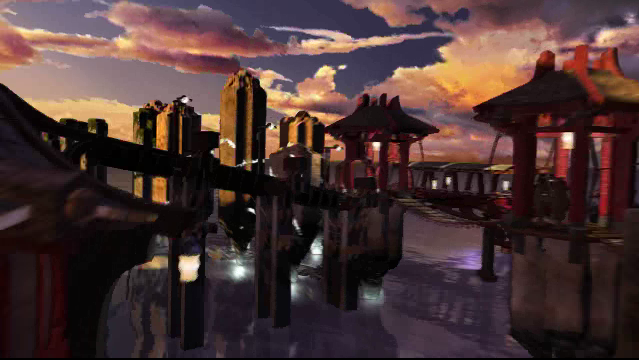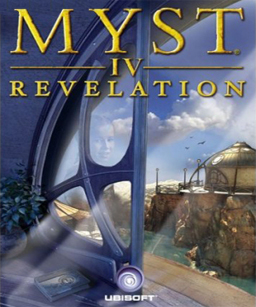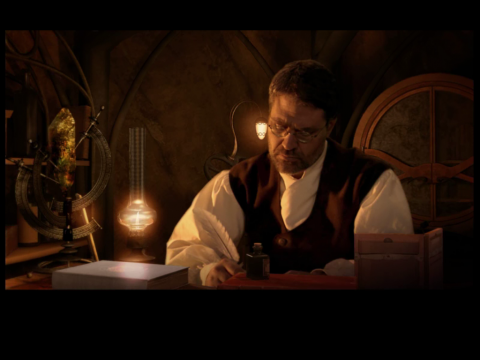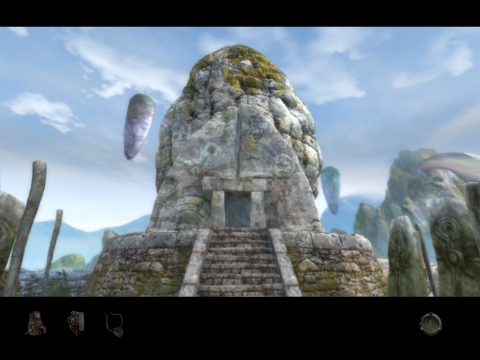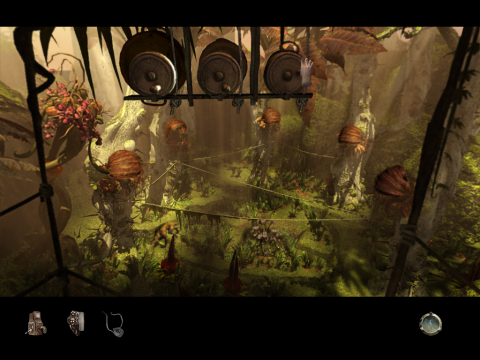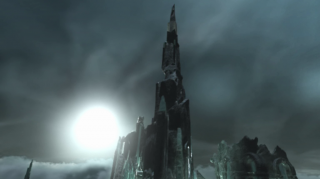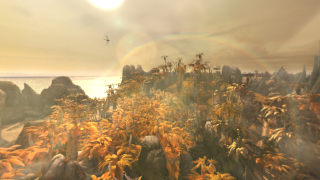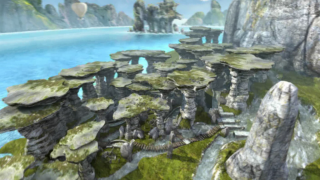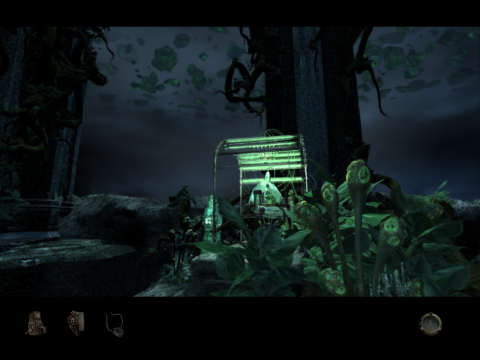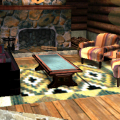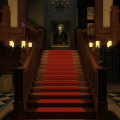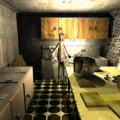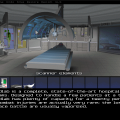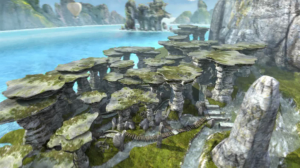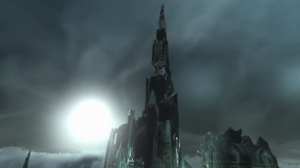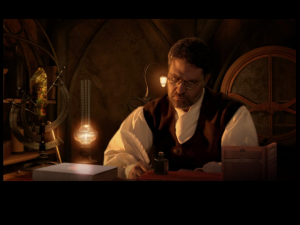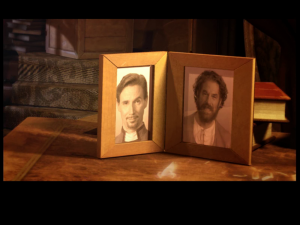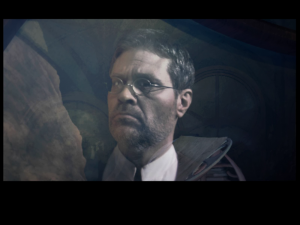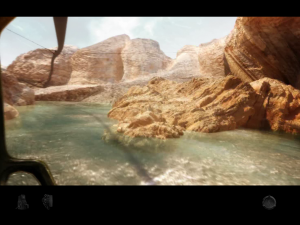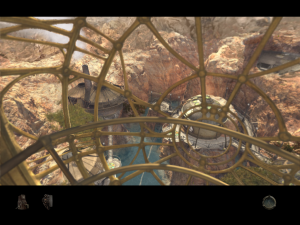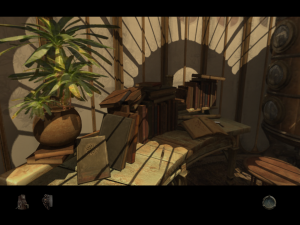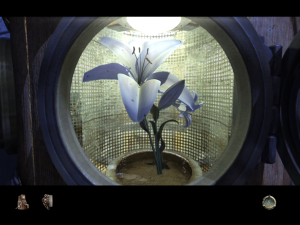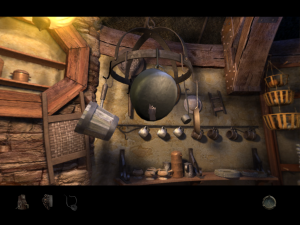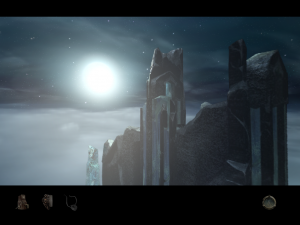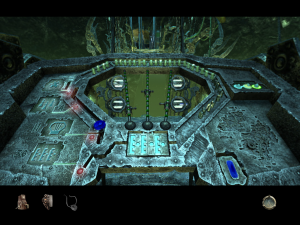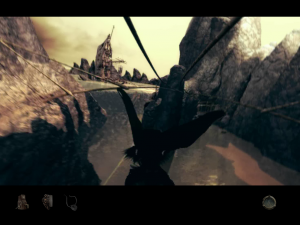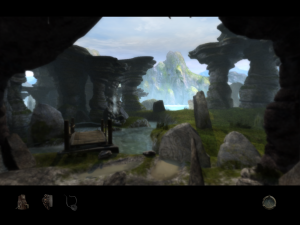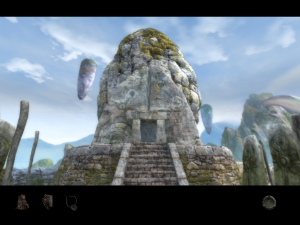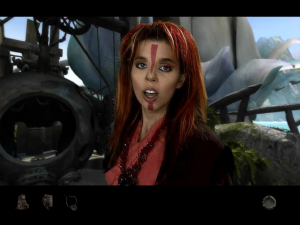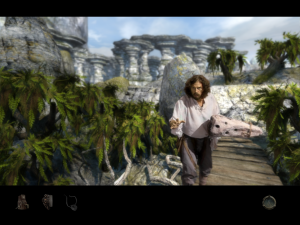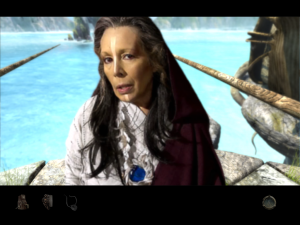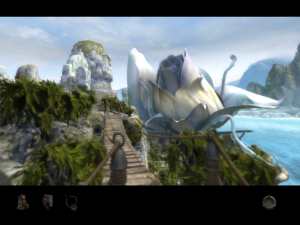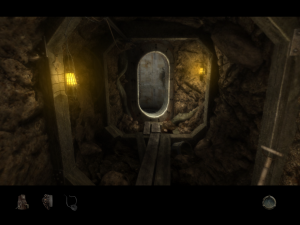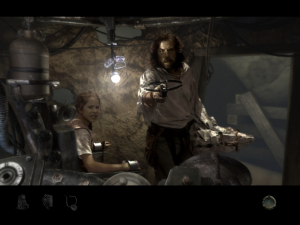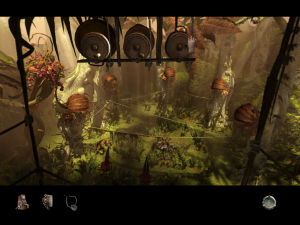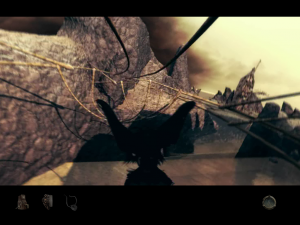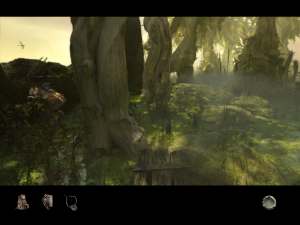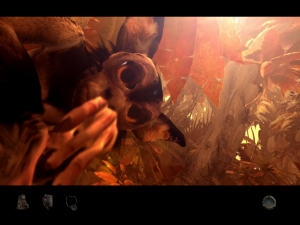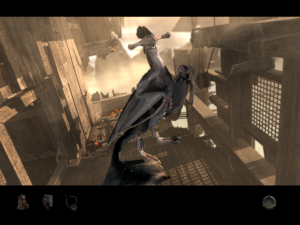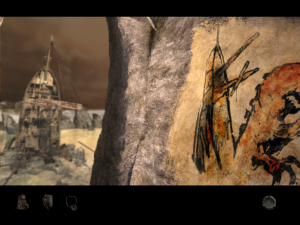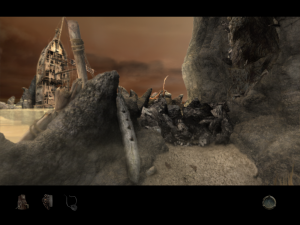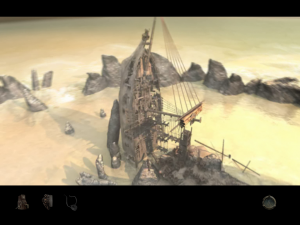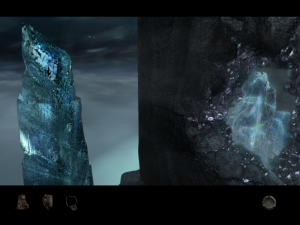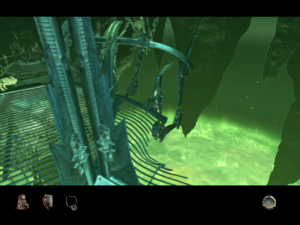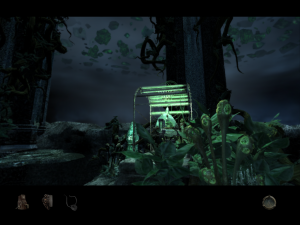- Myst (Introduction)
- Myst
- Riven
- Myst III: Exile
- Myst IV: Revelation
- Myst V: End of Ages
The fourth installment of the Myst franchise was once again handed out to a third party studio, this time to Ubisoft Montréal. The storyline undergoes a retconning in the fourth game, as Atrus’ two sons, Sirrus and Achenar, are no longer lost forever after their prison books were burned in the original Myst. Not only are their books no longer destroyed, but they are also full-fledged ages without an exit door, instead of one-man prisons. The game thus takes place 20 years after the first Myst. (Forced exile and family troubles are really recurrent themes here, aren’t they?) You can probably guess that your task is to explore these prison ages and see what happened to the two brothers. You are introduced to their kid sister Yeesha at the beginning of the game, but she gets kidnapped very early on, so you’ll have to save her as well.
The opening video once again shows Atrus pondering about the past on his writing table. Interestingly enough, the drawings of his two sons on the desk are now actual photo portraits. That’s probably because they are important characters this time around, or maybe they noticed the drawings were a little weird in Exile. They still kept Jack Wall’s over-the-top orchestral music, though, as he returns to work on Revelation as well.
The first moments of the game are absolutely gorgeous – a classic Myst ride on a monorail, this time through a sunny canyon over a river. The music hits the right notes as Yeesha tells you a little bit about her family and gives you the chance to take a picture of their very photogenic house. Sadly, after those first few shots, the graphics never reach that same level again. The first area, Atrus’ home in Tohmana (the same place where Exile begins), is also very well done. However, every area afterwards seems a bit less impressive, to the point where there are moments where it’s hard to be sure if there was step up from the third game in terms of graphics. At least Revelation lets you choose your resolution up to 1024×768.
There’s a bit more live-action this time around, it’s just too bad the acting is not that great. Rand Miller is fine as always as Atrus. Sirrus and Achenar are no longer played by Rand and Robyn Miller, but by completely different people. While Sirrus is mostly okay, despite being guilty of chewing the scenery once in a while, Achenar sounds really unconvincing and unconvinced. Isn’t he supposed to be the impulsive, aggressive brother? He does pick up the slack near the end, though. Yeesha has grown up from the baby in Exile and is now a young girl. The little girl portraying her is adorable, but she does have a French-Canadian accent, which some may find annoying. Anyway, nothing is as bad as all the priestesses that show up later in the game, all of them pointless and annoying. The “best” is the girl that has a hard time wrestling with the idea that she could take spare parts from one machine to fix another machine of the same type. The upside to all this acting is that every journal can also be read to you by its author, book on tape style.
While Revelation has kept the spherical stills from Exile, it has replaced the hyper-simple pixellated hand cursor for a fancy, animated 3D one. This new cursor reacts when in front of a hotspot, telling you what can be examined and what locations you can travel to. One problem is that the hand reverts too slowly to its original position, giving you the impression that there are hotspots everywhere if you move the cursor briskly across the screen. You also need to open doors and operate levers by holding the left mouse button and dragging the object. The problem with that is that doing such an action changes the camera from being centered on the cursor to only panning when the cursor reaches the edges of the screen. This is a switch you can do at any time by pressing the right mouse button, but the game decides to do this by itself any time you drag an object. It sounds minor, but it’s tiresome in the long run. To top it off, that 3D hand just looks ugly. Even worse: transitions between stills are slooow. In Riven, you could move as fast as your hand could point at the next hotspot. It might be the 360° spheres or the 3D cursor, but moving around in Revelation is long and tedious. Exile’s movement was a bit slow too, but Revelation’s is much worse. Myst is supposed to be known for its simple interface. Exploration should be as hassle-free as possible so you can spend time thinking about the bigger picture – the puzzles. Revelation’s zip mode does mitigate the problem, since it lets you instantly teleport to any important location in an age, but it’s simply not enough.
On the other hand, some interface changes are for the better. You are now given a photo camera and the ability to add text to your snapshots, so it’s a great feature for those who are not too keen on using pen and paper to note things. If something looks important, you just take a quick picture, so it’s five seconds of clicking instead of five minutes of recopying. However, it can be difficult to look at a picture and then input the information from memory, so paper still has its advantages. Luckily, you can also print your photos on paper to solve this problem.
Another item has been added to your inventory, one that’s a bit more controversial. You find Yeesha’s amulet lying on the ground early on and it lets you see visions of the past when looking at certain objects. Well, actually you mostly hear the visions, as very few are videos. The problem with these visions is that they’re kind of useless – they very rarely have anything to do with the puzzles and the storyline details they offer are kind of irrelevant, not to mention that there are much better ways of giving them to the player, like subtle elements in the environment or good old journals. Who knows why they thought they needed to resort to magic or ESP, but that pendant sure doesn’t fit the Myst theme. Anyhow, some of those visions are important, so you’ll have to check the amulet every time you hear the noise signifying there’s a vision associated with an object, just in case.
One last feature is that when your cursor is not on a hotspot, you can left-click to go “tap, tap” on any object to make a noise. Tapping on different objects will produce different sounds, like metal instruments clanging loudly, a wood table producing a dull ring and a stone wall making a very muffled sound. Anything your hand can reach, you can tap on.
The Ages
Spire
Spire is, well, a huge freezing spire made of nothing but various types of stones and crystals. As far as prisons are concerned, Sirrus really got the short end of the stick. The only life form and means of sustenance is a little bit of moss. The various crystals lets the programmers use a bunch of fancy lighting and transparency effects, but otherwise Spire is a bit barren, even if intentionally so. Sirrus is supposed to be the intellectual brother, so his puzzles involve scientific activities such as figuring out the properties of rocks, directing electrical current and using vibrations. It’s surprising that Sirrus could build complex electrical circuits from nothing but his two hands and an endless amount of stone, but hey, you have to suspend that disbelief of yours sometimes. The puzzles in this age are satisfying and not too difficult. The final puzzle is a doozy, but you are given more than ample information to figure it out without too much trouble.
As far as prisons are concerned, Sirrus really got the short end of the stick. Spire is, well, a huge freezing spire made of nothing but various types of stones and crystals. The only life form and means of sustenance is a little bit of moss. Yum. The various crystals lets the programmers use a bunch of fancy lighting and transparency effects, but otherwise Spire is a bit barren, even if intentionally so. Sirrus is supposed to be the intellectual brother, so his puzzles involve scientific activities such as figuring out the properties of rocks, directing electrical current and using vibrations.
Haven
Haven is the age of Achenar, the strong, hot-blooded brother, so he got an appropriate prison – a beach with a pirate ship full of plunder and a jungle full of animals to hunt. Haven has the most wildlife in any age of Myst so far – you can see many species from small insects to dinosaur-like herbivores, hammerhead pterodactyls and of course little cutesy monkeys. Not only can you see these animals up close, but you can also see them interact with each other, like a predator taking down its prey. With so many animals to see, you can bet that some of this is going to be important. It’s also interesting to note that Achenar built several camps on the age and visiting each one betrays an evolution in his mindset – he goes from a gruff brute to a lovey-dovey nature lover that lives with monkeys.
Speaking of puzzles, there’s one in Haven that’s notable for being particularly difficult – it requires you to send sound messages to monkeys in order to help them fight against a predator. The problem is that not only are the steps needed to succeed unclear, but the game also often fails to register the commands you’re trying to send. You need to spin wheels to activate sound machines, but you’re never told how long those sounds need to be or how many time the wheel must be turned. Stupid monkey, why won’t you throw that rock? Ubisoft even released a patch to loosen the timing of the puzzle, something that has never been necessary in earlier games.
Serenia
Serenia is the third and final age, which you can only complete with the help of information found in the two previous ones. The exploration is bad enough in Revelation, but Serenia just adds insult to injury. It is supposed to be some kind of lush paradise, but the place is just wrong. It’s full of New Age silliness like floating soap bubbles, memory chambers, spirit guides, dream worlds, life stones, palm readings… and a bunch of chicks that are really into togas and face painting. Seriously, there are like six different women that show up and none of them have anything helpful to say except gobbledygook about dreams and spirits. Yeesha loves the place, so maybe it explains why she turns out to be such a hippie later in Uru.
It makes no sense that these people would have to commune with the spirits of their ancestors in their dreams to find somebody that’s two hundred meters away from them. And everyone is on a tiny island! Less LSD, more observation. The worst bit is that you’ll be forced to go on your own spiritual journey, with wonky visuals, trippy music, magic wormholes and everything. At least your spirit guide is voiced by Peter Gabriel, so that’s pretty stylish.
However, before you can go on your little mental trip, you need to give a gift to get a spirit guide. Can’t travel dreams without one of those, don’t you know? The difficulty is that the gift in question will break if you move the cursor too quickly and will also break if you take too long before giving it, and the spirit guide will change spots if you screw up. Later on, you’ll also need to redirect water by blocking certain rivers. The problem is that you have to navigate in a maze where it’s impossible to visually follow a river to see where it ends. Both these puzzles are done in the same area, so prepare to get sick of seeing the same scenery over and over again. Maybe it’s the setting or maybe the game is too long, but all of the final puzzles feel extremely irritating. You think that the game is about to end so you start getting pumped up to see the conclusion, but then, bam! The game throws you a puzzle wall. And then another. And another.
In conclusion, Myst IV is the weakest of the series. While the production values are there and the graphics fairly high quality, a lot of things prevent it from being too enjoyable. The final third of the game in Serenia is much too long, and the puzzles require a lot of tedious back and forth. The other areas are much better, but the awkward exploration makes the puzzles more tedious than they should be. There’s also too much live-action, character visions and voiceovers. All this chatter doesn’t really suit Myst, but what makes it really mind-numbing is that the acting just isn’t very good. Exile and Revelation proved that the Myst franchise is best left in the competent hand of Cyan, which is exactly where Myst V comes in.
